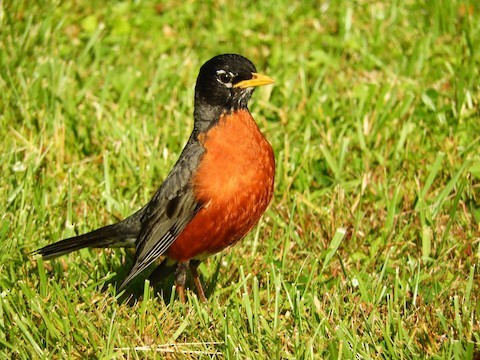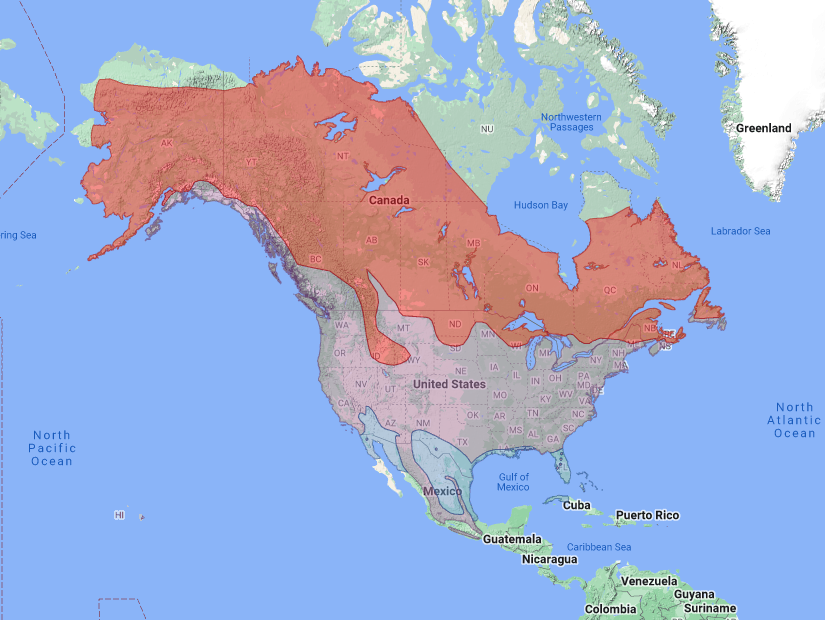Birdfinding.info ⇒ Among the most familiar North American birds, the American Robin is common-to-abundant in all regions of the continental U.S. and Canada. Well-adapted to human development, it is ubiquitous in suburban and rural settlements throughout both countries, often foraging conspicuously on lawns and sometimes nesting in the eaves of houses.
American Robin
Turdus migratorius
North America, in all types of woodlands and semiopen habitats, including agricultural and settled areas.
Comprises two distinct forms, which have been regarded as separate species:
“American Robin” (migratorius): widespread, discussed in detail below.
“San Lucas Robin” (confinis): endemic to the Sierra de la Laguna in the Cabo San Lucas region of Baja California Sur, discussed in detail here.
Breeding. Nests abundantly in various kinds of woodlands—including the full spectrum of evergreen, mixed, and deciduous forests, riparian corridors, leafy suburbs, savannas, and other semiopen landscapes with scattered trees—across most of North America from Alaska and arctic Canada south in the Mexican highlands to Oaxaca and in the east to the Gulf of Mexico.
Northern breeding range extends locally beyond treeline in riparian willow thickets: in Alaska, west to Cape Thompson, the Seward Peninsula, the Yukon-Kuskokwim Delta, and the outer Alaska Peninsula (to Port Moller), and north to the northern foothills of the Brooks Range. Eastward across northern Canada, it extends locally north to the Beaufort Sea coast from the Mackenzie River Delta east to Paulatuk, and to the Coronation Gulf, Bathurst Inlet, Baker Lake, Rankin Inlet, and the northernmost tip of Quebec; possibly also to southern Baffin Island (apparently regular at Iqaluit).
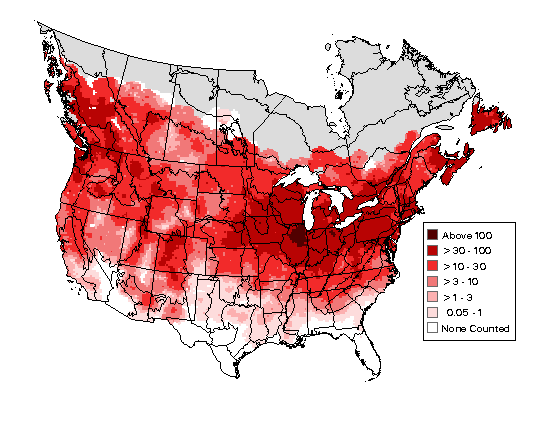
Breeding Bird Survey Abundance Map: American Robin. U.S. Geological Survey 2015
Breeding range across southern Canada and the continental U.S. generally includes most areas that are either forested or developed residentially with extensive lawns and gardens, but mostly absent from Florida and southern Texas.
In Mexico, it breeds extensively in the Sierra Madre Occidental from Sonora and Chihuahua south to Colima and Michoacan, and eastward across the central volcanic belt. Also breeds locally in northern Baja California, the Sierra Madre Oriental from Monterrey south to central Oaxaca, and the Sierra Madre del Sur of Guerrero and southern Oaxaca.
Movements. In winter, it generally withdraws from Alaska and most of the Canadian interior, but remains in coastal regions north to the Alaska Panhandle and Newfoundlland, and around the Great Lakes, and occupies nearly the entire continental U.S., including southern Texas and peninsular Florida, and most of Mexico south to the Isthmus of Tehuantepec, and locally south to central Baja California (casually south to Cabo San Lucas region, where it can be confused with the isolated local resident “San Lucas Robin”).
Small numbers remain in settled areas far north of the main winter range, although most of these stragglers probably do not survive all winter.
Regular as a fall and winter vagrant on Bermuda, the Yucatán Peninsula, western Cuba, the Bahamas, and the Bering Sea islands of Alaska (but apparently unrecorded from Asia).
Across the Atlantic, it has been found somewhat regularly as a vagrant to Great Britain, Iceland, and the Azores. There are a handful of records from Belgium, the Netherlands, and Spain.
Identification
Distinctive in its range: a large, robust thrush with rufous underparts, gray-brown upperparts, a blackish head, and a yellow bill.
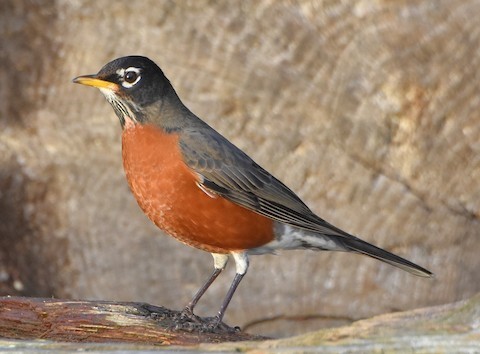
American Robin, male. (Camano Island State Park, Washington; December 24, 2020.) © Carol Riddell
Facial markings are somewhat variable. Usually shows three distinct white markings around the eye: a crescent above, a crescent below, and a supraloral bar. The chin is white and throat is streaked black-and-white.
The sexes are similar, but not identical. Males show the boldest coloration—this is especially noticeable on the upperparts, where they usually appear gray overall with a distinctly black head and crisp white facial markings.
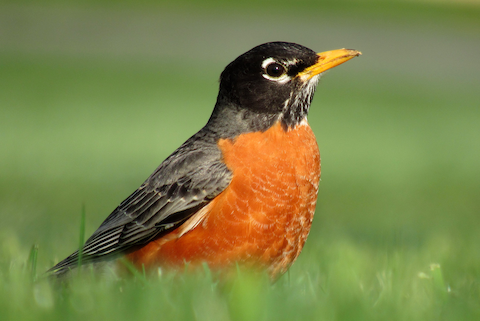
American Robin, male. (Winding Hills Nature Trail, Mechanicsburg, Pennsylvania; April 16, 2020.) © Brett Matlock
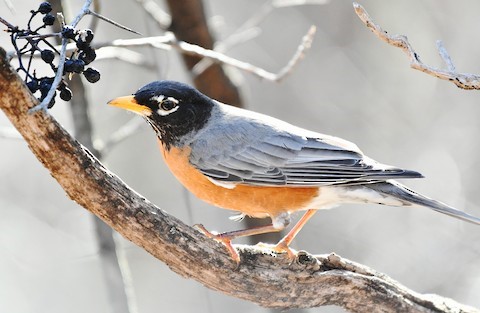
American Robin, male with pale-gray upperparts and contrasting black head. (Wehr Nature Center, Franklin, Wisconsin; April 19, 2020.) © Russ Boushon
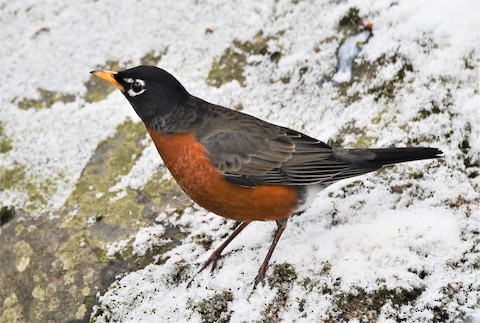
American Robin, male at the dark end of the spectrum. (Parc Lepage, Rimouski, Quebec; February 16, 2020.) © Vincent Giroux
Females are less rufous below, paler and browner above, and often show more extensive, but indistinct, pale facial markings.

American Robin, female. (Oso Creek, Mission Viejo, California; March 30, 2021.) © Tom Fangrow
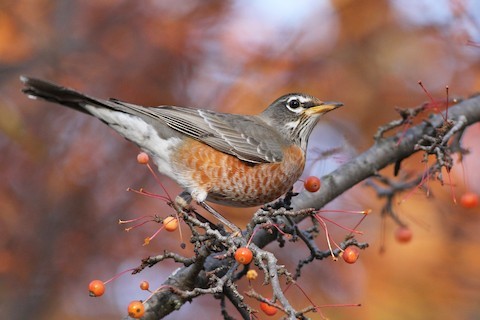
American Robin, female with extensive white facial markings. (Leverett Pond, Olmsted Park, Boston, Massachusetts; November 19, 2014.) © Evan Lipton
Regional populations vary in the depth of their pigmentation, and to some extent also in pattern.
In general, northern and eastern populations are bolder and darker overall—reaching peak intensity in Newfoundland—and typically show bold, white corners on their outer tail feathers.
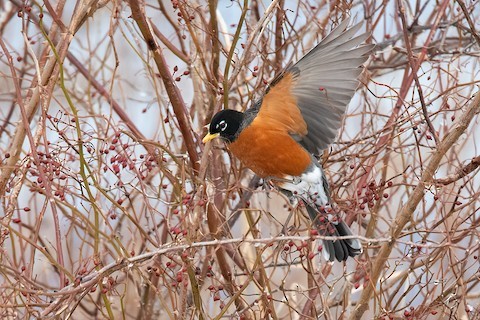
American Robin, male showing rusty wing-linings and white lower belly and undertail coverts. (Wolfville, Nova Scotia; March 27, 2020.) © Richard Stern
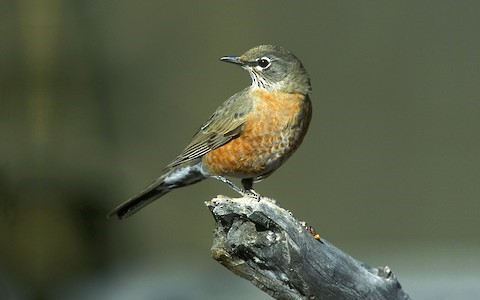
American Robin, female. (Mount Pisgah, Nevada; September 25, 1998.) © Jerry Liguori
Southwestern populations tend to be paler and browner, and often lack distinct white corners on their tails.
In fall, some females (or perhaps immatures of both sexes) are much paler than the typical adult plumage and can be mistaken for some Asian and Neotropical Turdus species.
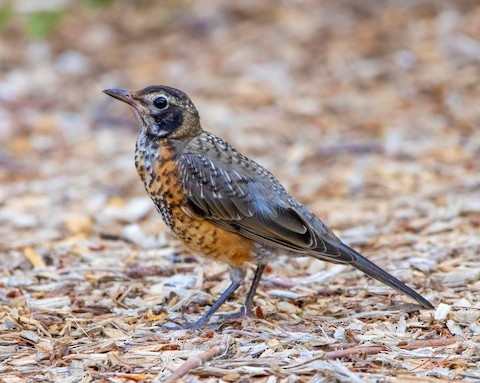
American Robin, juvenile. (Wall Park, Bethesda, Maryland; June 20, 2021.) © Nick Hobgood
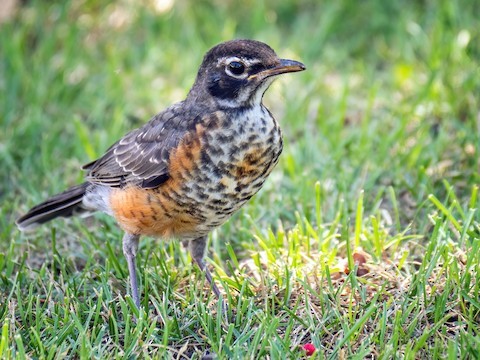
American Robin, juvenile. (Domaine St.-Paul, Montréal, Quebec; July 18, 2020.) © Danielle A.
Juveniles have dark upperparts and pale, variably reddish underparts, heavily spotted.
“San Lucas Robin”. Differs from the widespread migratorius (and related subspecies) mainly in having paler, buffy underparts, uniformly pale-gray or grayish-brown upperparts (including the head), a continuous white brow-stripe, and no noticeable differentiation between the sexes.

“San Lucas Robin”, T. m. confinis. (San Antonio de la Sierra, Baja California Sur, Mexico; June 26, 2017.) © Dubi Shapiro
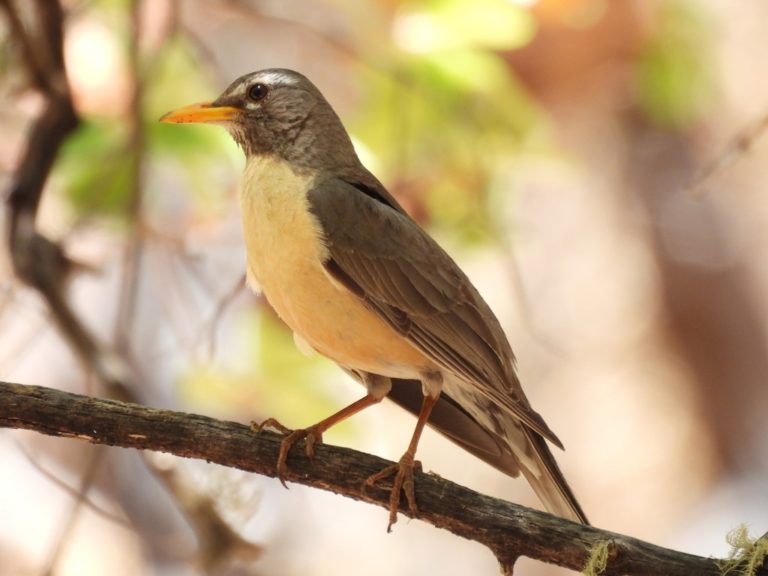
“San Lucas Robin”, T. m. confinis. (Sierra de la Laguna, Baja California Sur, Mexico; May 25, 2022.) © Osiel Flores
Notes
Polytypic species consisting of seven recognized subspecies, one of which is sometimes classified as a separate species, the “San Lucas Robin” (confinis).
Several authors and taxonomic authorities have regarded the “San Lucas Robin” as a separate species, recently including the Handbook of the Birds of the World and BirdLife International, while others regard it as a geographically isolated pale race of migratorius. In 2022, the American Ornithological Society Classification Committee rejected a proposal to reclassify confinis as a separate species.
More Images of the American Robin
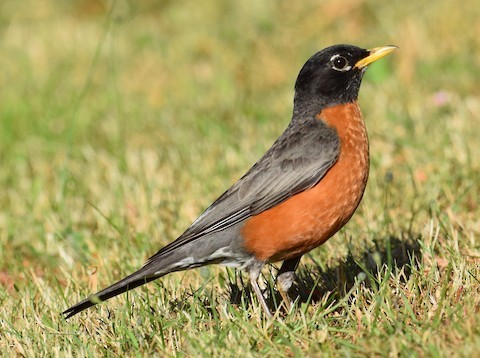
American Robin, male, with limited white on the face. (Stillwater, British Columbia; July 11, 2017.) © Lorenzo Vinciguerra
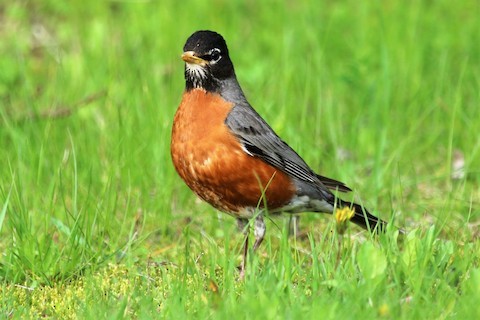
American Robin, male. (Parc Centenaire William Cosgrove, Montréal, Quebec; May 22, 2019.) © Luc Tremblay
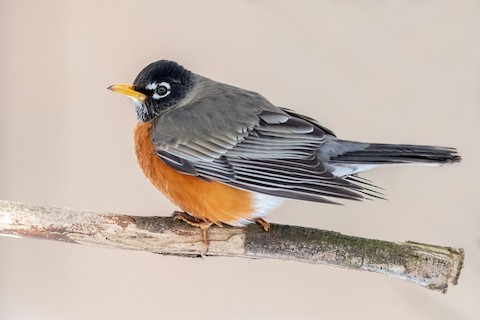
American Robin, male. (Granville, Ohio; February 14, 2021.) © Brad Imhoff

American Robin, male. (Peterborough, Ontario; March 11, 2022.) © Ezra J. Campinelli
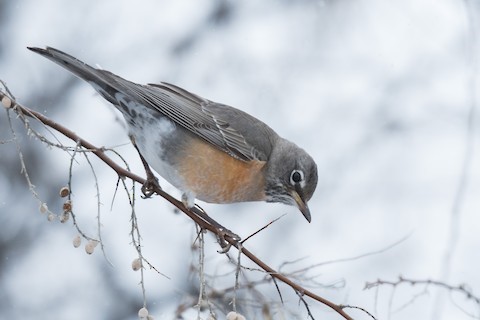
American Robin, female, an exceptionally pale individual. (Wilson Spring Ponds, Nampa, Idaho; February 9, 2019.) © Ian Hearn

American Robin, female. (El Paso, Texas; October 1, 2020.) © Ad Konings

American Robin, juvenile. (Malheur National Wildlife Refuge, Oregon; September 9, 2021.) © Noah Strycker
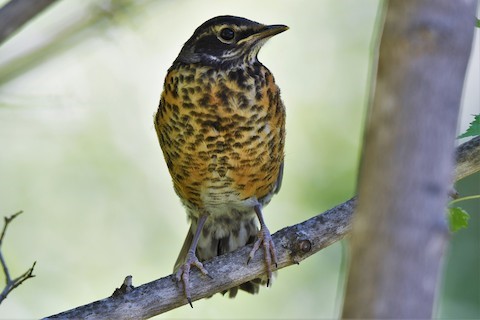
American Robin, juvenile. (Wasilla, Alaska; June 21, 2022.) © Timothy Piranian
References
Alderfer, J., and J.L. Dunn. 2014. National Geographic Complete Birds of North America (Second Edition). National Geographic Society, Washington, D.C.
BirdLife International. 2021. Turdus migratorius. The IUCN Red List of Threatened Species 2021: e.T103889499A139392811. https://dx.doi.org/10.2305/IUCN.UK.2021-3.RLTS.T103889499A139392811.en. (Accessed August 21, 2022.)
eBird. 2022. eBird: An online database of bird distribution and abundance. Cornell Lab of Ornithology, Ithaca, N.Y. http://www.ebird.org. (Accessed August 21, 2022.)
Howell, S.N.G., and S. Webb. 1995. A Guide to the Birds of Mexico and Northern Central America. Oxford University Press.
Kirwan, G.M., A. Levesque, M. Oberle, and C.J. Sharpe. 2019. Birds of the West Indies. Lynx Edicions, Barcelona.
Mullarney, K., L. Svensson, D. Zetterström, and P.J. Grant. 1999. Birds of Europe. Princeton University Press.
Raffaele, H., J. Wiley, O. Garrido, A. Keith, and J. Raffaele. 1998. A Guide to the Birds of the West Indies. Princeton University Press.
Salt, W.R., and J.R. Salt. 1976. The Birds of Alberta. Hurtig Publishers, Edmonton, Alberta.
Sibley, D.A. 2000. The Sibley Guide to Birds. Alfred A. Knopf. New York.
Xeno-Canto. 2022. American Robin – Turdus migratorius. https://xeno-canto.org/species/Turdus-migratorius. (Accessed August 21, 2022.)
